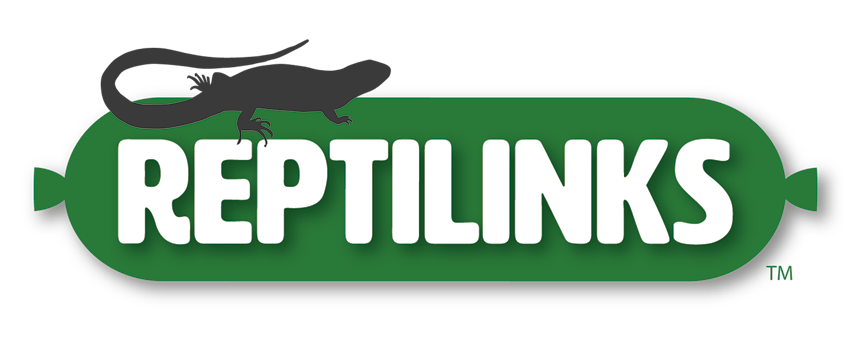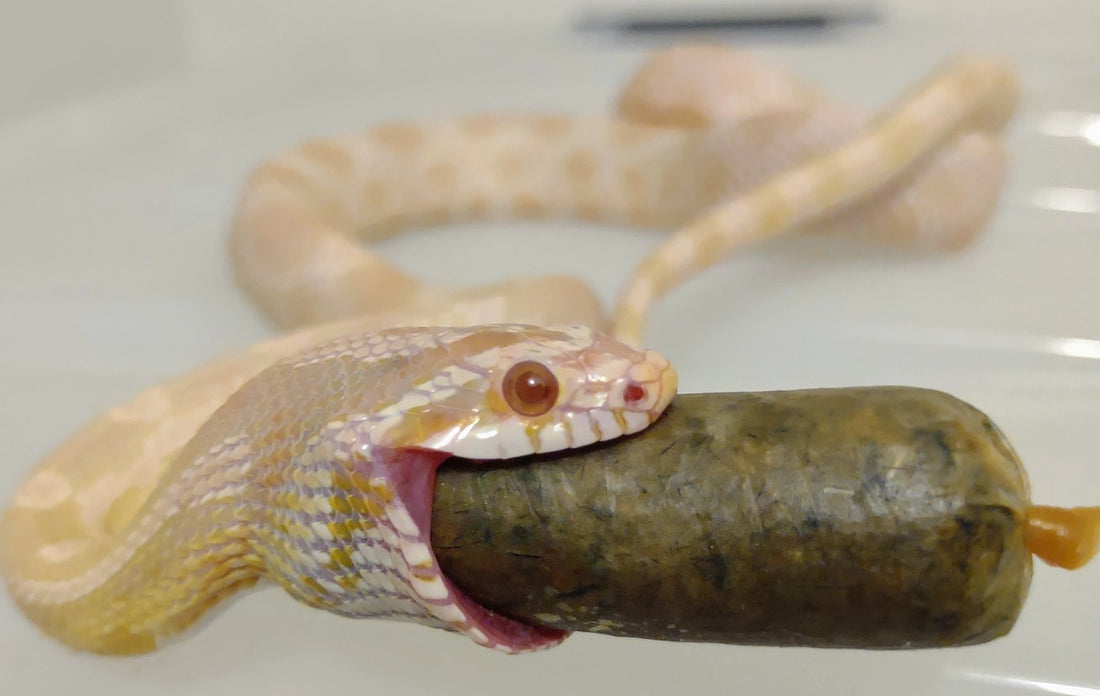Reptilinks Are the Perfect Food for Your Corn Snake—Here’s Why
Guest Article by C. Voyles
Ever feel like your corn snake would benefit from something new when it comes to food? Having a hard time getting your picky snake to take a mouse? While some people report success after trying mice that are a different color or even warming up their F/T prey so that it seems alive, Reptilinks are a great food source for your corn snake too! From enrichment to breaking a food strike, Reptilinks are the perfect food for your corn snake—and here’s why.
Understanding Your Corn Snake’s Needs
While corn snakes can be hardy eaters, like many reptiles, it’s not necessarily uncommon for them to go off food. This might happen if their environment isn’t quite right (maybe it’s too hot or too cold), but more often, it’s a result of brumation. If your corn snake has decided to slow down during the cooler months, they may temporarily stop eating, even if they’re still drinking and basking. Or, sometimes, your corn snake might just seem to go on a food strike for seemingly no reason at all.
While you can’t control a picky snake who’s decided that they only want to eat brown mice with white spots and only on Tuesday evenings, there are many parameters within your control that could be impacting why your corn isn’t eating.
Habitat Needs
First and foremost, have you provided an enclosure that is appropriate for your corn snake? In general, 48L x 18W x 22H is considered an appropriately sized habitat for an adult and supports your corn’s natural behaviors. Younger corns can gradually work their way up to this size. A basking spot of 85 to 90 degrees is ideal, which you can achieve by using a basking bulb. On the opposite side of the enclosure, make sure that your snake can cool down to around 75 degrees—or down to 70 at night, when the heat of the day tapers away. Avoid the use of heat rocks, which are difficult to safely monitor and can pose a burn risk to your snake.
The best way to make sure that your corn snake is getting the right temperature gradient is to use a laser (infrared) thermometer. This functions like a laser gun that you point at a surface to read the temperature. After all, what matters is the surface temperature your corn snake is basking on, not the temperature in the air around that surface! That’s why temperature gauges aren’t often very helpful.
Ambient or ground temperature can be measured with a thermometer probe, which will display the temps in real time. Corn snakes don’t rely too much on humidity, so as long as your home sits at between 30% and 40% (which most homes do), you shouldn’t encounter much of a problem. Provide fresh water in a clean bowl daily.
Lifestyle Needs
For keepers, snakes that go on a hunger strike can be distressing. Is your reptile companion going to starve? This often prompts keepers to try new and varied diets to tempt their corn into taking a meal. In reality, it’s a great thing to offer variety! Changing up your corn snake’s food sources—either to break a food strike or just for fun—is a great source of enrichment that challenges their brains and encourages healthy behaviors.
Corn snakes typically take a meal once every 7 to 14 days depending on their size and age. This is a lot of opportunity for enrichment at mealtimes. Reptilinks are an ideal tool in your arsenal, and the reason why comes down to your corn snake’s biological needs. In the wild, a corn snake enjoys a wide range of small mammals for its meals. Mice and voles are just the tip of the iceberg, with corns consuming small birds, eggs, and even the occasional tiny lizard or amphibian if the opportunity presents.
This means that they are eating a wide range of prey, all of which are slightly different in their nutritional composition. The proper balance of calcium, phosphorus, and other nutrients is critical for keeping snakes healthy and preventing metabolic bone disease. In captivity, mice and rats are the staple, but your corn could benefit from the wide range of vitamins and nutrients that a varied diet offers, just like in the wild.
That’s where Reptilinks come in.
How Reptilinks Can Help
Mice and rats offer important protein and minerals, but feeding the same thing over and over again can leave your corn snake craving other nutrients. Reptilinks’ Mega Blend links, for example, mix together many of a corn’s natural prey species, including small birds and even bullfrogs. This formulation offers a superior calcium to phosphorus ratio, which is critical for keeping your corn’s bones and organs healthy. Links are created from whole prey, which means that the entire animal—bones, organs, feathers, fur, and all—is ground into a bite-sized link. Since corns are meant to eat their prey whole, Reptilinks work well as a natural diet supplement or even replacement.
Of course, the nutritional balance of Reptilinks is just the start of why so many people have switched their corns either partially or entirely to this type of diet. The links are very convenient to feed, with no need to do any preparation outside of thawing them. In fact, they can be stored in the refrigerator for up to a week before feeding time, which isn’t something that’s safe to do with F/T mice. They’re also robust enough to hold up to a corn snake’s strike, so the contents won’t spill out as soon as the casing is punctured during feeding.
For people who find the practice of feeding whole prey to their corn snakes a tough challenge (mice can definitely be cute!), Reptilinks are a great alternative. And your corn snake will appreciate them too, because Reptilinks are easy on their stomachs. Instead of your snake shifting constantly to make room for the uncomfortable poking of a mouse’s foot in its stomach, links are smooth and easily sit comfortably in the digestive tract. The helps aid digestion and keeps your corn relaxed at the same time, making mealtimes a positive experience.
Remember—taking care of your corn snake the right way and asking for help from an exotic vet are the first steps toward making sure that your corn’s hunger strike ends. Reptilinks isn’t a substitute for vet care or a proper setup; we want to encourage healthy corn snakes to make the switch!
Will a Corn Snake Eat a Reptilink?
If Reptilinks sound like something your corn could benefit from, your next question is likely, “Will my corn snake eat something that’s not a mouse?” The short answer is: most definitely! They eat animals of all shapes and sizes in the wild.
Sometimes, it can take some practice to get your corn snake excited about a link, especially if they’ve been eating nothing but mice for years. Old habits die hard, after all. The good news is that the scent of Reptilinks is often too tempting, because the links smell just like the whole prey that they’re made from. If the scent alone does not entice your corn snake to strike, there are some other things you can do to liven up feeding time and encourage them to take their meal. Most people whose corns have tried Reptilinks once never have a problem getting them to strike at a link again.
The first time that your corn encounters a Reptilink, consider lying the link in a dish or tray so that they can investigate the smell. Many will choose to eat with no further prompting once they adjust to the new food item in their enclosure.
For less excitable hunters, encourage their natural instincts by slowly moving the link. Pass it by their face to give them a smell, and then allow it to wobble and move to mimic live prey. Feeding with tongs is encouraged, not only so that your hands are safely away from the strike zone, but also so that your scent doesn’t become synonymous with mealtime.
If your corn still isn’t interested, make sure that you’re feeding the appropriate size. Reptilinks are more calorically dense than most prey items (just about double), so take this into consideration when planning your corn snake’s schedule. You can feed smaller links or space out feedings less often to suit your reptile’s preferences and health needs. Either way, Reptilinks typically end up as the more economical option.
Recommended Reptilinks for Corn Snakes
In order to achieve the best results for your corn snake, we recommend sticking to smaller whole prey link variations—prey that the snake would likely encounter in the wild. This means that the Mega Blend links can work well, as do Quail, Rabbit, and Frog varieties or any mix thereof. Micro and mini links are available for young corns who are not up to taking larger sizes. Remember, a food item should never exceed the width of the largest part of the snake! Many of our customers who are corn snake breeders seem to have the best luck with the quail varieties, so we recommend getting the quail micro/mini/mini+ links for hatchlings and juveniles, and the cased quail links for sub adult and adult corn snakes.
Below is a chart demonstrating Reptilinks equivalents to their rodent prey counterparts.

Whether you’ve got a problem eater on your hands or you just want to add some variety to your corn snake’s life, Reptilinks are a trusted source of nutrition. They are best stored for several years in the freezer, so don’t hesitate to stock up! We get our whole prey from local Ohio farmers, so you can trust the quality of the animals that go into making our wide variety of links. Once your vet has cleared your animal of any health problems, Reptilinks are a great way to liven up their mealtimes and help them stay strong and resilient.

